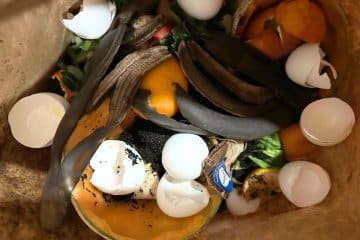Homeschool schedule in the summer, you ask? Well, it's really more of a summer routine. We homeschool year-round, yet move at a more gentle pace through the summer. Basically, we focus on reading for fun, writing for fun, and hands-on learning outdoors. However, as a busy homeschooling and working mom, I need a routine as much as the kids do.

Here's the lowdown on how to homeschool through the summer and why we stick to a homeschool summer routine, plus some tips on creating the best homeschool schedule for your family.
Jump to:
- Reasons We Homeschool in the Summer
- 1. Unique Hands-On Summer Learning Opportunities
- 2. Reinforces a Love of Learning
- 3. To Catch Up or Review
- 4. Makes it Easier to "Get Back To School" in September
- What We Include in Our Summer Schedule
- How I Create Our Summer Homeschool Schedule
- Our Summer Homeschool Schedule is Relaxed
- Our Monday to Friday Summer Routine
- Let Your Summer Homeschool Routine Flow
- 6 Steps to Planning Your Summer Homeschool Schedule
- Summer Homeschool Schedule Advice
Reasons We Homeschool in the Summer
As any homeschooling family will tell you, it's a lifestyle. In our case, homeschooling and homesteading off the grid means our children get some pretty unique learning experiences, regardless of the season.
Yet as we live very far north, there's a pretty dramatic difference in daylight hours depending on the season. And the summer months are short, but the days are long. We get almost 24 hours of sunlight through June, July, and into August.
1. Unique Hands-On Summer Learning Opportunities
These long days offer the opportunity for unique hands-on summer learning that our kids don't get in other seasons.
For example, nature walks and picnics allow for hands-on outdoor nature studies, spontaneous art sessions, and foraging berries and wild edibles. These activities extend the natural science education available in our science curriculum.
Related: How We Use Foraging to Teach
2. Reinforces a Love of Learning
Continuous learning as a lifestyle is an important family value I hope my children will embrace. So, by continuing a gentle summer homeschool schedule, we're reinforcing the idea of self-education and learning as a natural part of daily life. And homeschooling through the summer helps strengthen this idea.
3. To Catch Up or Review
Sometimes, despite our best efforts, we don't make it through our curriculum during the traditional September-to-June school year.
Family moves, health issues, and other "real life" challenges may mean we have a few weeks left of school work to complete as we creep into July. And that's okay.
We can catch up over the summer and start our new year's curriculum in September. We also get a jump on our homeschool organization by clearing out old and unused items.
We're going into our ninth year of using Sonlight® as our core curriculum. Sonlight is a literature-intensive program, which fits our family culture perfectly (everyone's a reader here). And by sticking to a relaxed homeschool schedule during the summer, the kids have the chance to revisit their favorite books from the previous months.
Some weeks we visit the library to borrow more books on a new favorite topic. We catch up on our favorite book series. This year it's the Little House on the Prairie series. Little House in the Big Woods is one of our favorite chapter books for 2nd graders.
And if there's a challenging subject, (this year it's Grade 2 Singapore Math) review it - just a little - each day through the summer.
4. Makes it Easier to "Get Back To School" in September
It's a lot easier for us to stick to a homeschool routine all year (we take time off throughout the year, though) than to stop cold turkey for two months each summer. Although I do give the kids more freedom to learn what interests them in the summer.
Yet having a loosely structured day lets them ease back into our more structured schedule when September rolls around.
What We Include in Our Summer Schedule
Aside from catching up or reviewing, we usually don't include much textbook work during the summer. Instead, our homeschool routine may include activities like
- nature studies and nature walks
- one page of math review each day (10 minutes, tops)
- summer reading in the hammocks on our deck
- wilderness living skills
- art study outside
- poetry picnics
- foraging
- fishing
- gardening
- canning and preserving
- educational board games, trivia games, and card games - great when you have guests!
- family history to go along with visits to our family members
- swimming lessons in town
I try to keep our summer homeschool relaxed and enjoyable. Although I have a loose idea of what I want our homeschooling summer schedule to look like, I prefer to think of it as a routine. So it's a more leisurely pace for everything.
How I Create Our Summer Homeschool Schedule
Our summer homeschool schedule changes from year to year. It's based on five things:
- our travel plans
- family visits
- our children's interests
- household/homesteading planned projects (renovations, repairs, etc.)
- our previous year's progress
We generally don't use a homeschool schedule during family trips. Instead, we complete social studies pre-work and travel journals.
And when family visits (including one of our five big kids), our homeschool schedule gets pared right down. We might do just one page of math and two pages of Language Arts per day.
If one of the girls has shown interest in a particular topic (like chickens or deer) we'll make time for it during the summer days. And as we believe that a solid home education includes learning life skills, our summer homeschool schedule also considers our summer house and homesteading projects.
Our Summer Homeschool Schedule is Relaxed
Here's what it looks like.
Our Monday to Friday Summer Routine
Morning Routine (breakfast, personal hygiene, summer morning chores)
One Math Lesson (Math U See Pre-Algebra for my 12-year old and Math U See Delta for my nine-year-old.)
Two Pages of Language Arts (Either 15 minutes of journal writing or a creative writing prompt.)
Mom Read Aloud Indoors or Outdoors From Sonlight Core H, Sonlight Core D, or our own family favorites. This summer our summer family read-alouds will include
- Emily Climbs, Lucy Maud Montgomery
- Penderwicks in Spring, Jeanne Birdsall
- Swallowdale by Arthur Ransome (this whole series has been a Harbour family favorite for 60+ years)
- The Wind in the Willows, Kenneth Grahame
- Underground to Canada, Barbara Smucker
Gardening Activities/Household Projects/Time With Guests
Lunch
Outdoor Play/Nature Studies/Foraging - this is really child-led. Usually, the girls will go out to play, and if I wander out, they'll want to show me something they found/saw, which turns into a nature study.
Snack
Indoor or Veranda Quiet Time - reading or drawing individually for the kids. I spend this time on administrative work activities or my reading for enjoyment. At the end of the summer, this may get replaced with two weeks of swimming lessons in town - we'll see how July goes first.
Dinner Prep - mom-led, with one or more helpers!
Dinner - we're working on more campfire cooking and cast-iron recipes for the outdoors!
Free Time/Fishing With Dad - this can go on for hours. Yet the girls love it, Dan loves it, which could result in fresh fish for tomorrow's dinner. And this also gives me time to catch up on writing work.
Let Your Summer Homeschool Routine Flow
Do you notice anything? That's right - I don't have any times listed.
That's because, in the summer, we relax a bit.
If we start the day at 10:00 am because the kids were still fishing at 9:00 pm with their dad, so be it. Or if we feel like lazing in the deck hammocks and reading for two hours instead of one, great.
That's why I prefer the word "routine" instead of "schedule" when homeschooling during the summer.
6 Steps to Planning Your Summer Homeschool Schedule

If you're struggling to organize your homeschool days this summer, use these steps to get on track.
- Schedule any family trips.
- Decide if you want your kids to keep up with homeschooling while away (some families I know still bring math and language arts workbooks on their trips).
- Note any academic areas of concern you want to focus on in the summer. This could be reviewing tough topics or finishing up curriculum or workbooks so your child will be ready for the new topics you plan to introduce in September.
- Prioritize this area and tackle it first thing each day. Yet don't spend hours on it every day. Otherwise, your child may resent you and dislike the "problem" topic even more. Spend no more than 15 minutes each day on it.
- Note any season-specific learning opportunities in your home, family, or local area. Schedule these in (i.e., farming or homesteading summer projects)
- Ask your child what they want to do this summer. And if they say "nothing," ask them what "nothing" looks like! In our case, my nine-year-old wants to sit outside and draw or read. We'll continue using Artistic Pursuits and finish up Sonlight's Grade Six Readers and library books. This summer, my girls are finishing up Grade 7 and Grade 4and they're both very strong readers. So I'm always adjusting their reading lists. I use reading lists from Not Consumed, The Good and The Beautiful Booklist, or retired Sonlight titles to keep them in good books through the summer.
Summer Homeschool Schedule Advice

My best advice when it comes to your homeschool summer schedule? Be flexible, get outdoors, and look for learning opportunities that aren't available at other times.
Try keeping homeschooling light and fun through the summer months. This keeps your child's mind active yet gives them a break from the rigors of the regular school year. And use this time to make great family memories to return to when those long winter homeschooling days return.

As a homeschooling mom, you've likely noticed that this spring's weather has been unpredictable, with its fair share of wild storms and gusty winds. But fear not because I'm here to help you transition smoothly into the sunny days of summer!
Together with some of my fellow bloggers, I've curated a fantastic collection of summer resources tailored specifically for homeschooling families like yours.
My selection includes imaginative craft projects to spark creativity, bucket lists to inspire new adventures, boredom busters to keep the kids engaged, and a treasure trove of freebies to enhance your homeschooling journey.
So go ahead and explore the tips and resources below, and prepare for a summer that's as enriching as it is unforgettable for you and your family.


Sarita Harbour is a long-time freelance writer, blogger, and homesteader who has been creating online content for over 15 years. She’s the founder of An Off Grid Life, where she shares practical advice on self-reliance, homesteading, off-grid living, and homeschooling based on her 11-year adventure living in Canada’s remote Northwest Territories.





